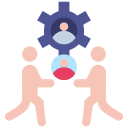Today’s Theme: Group Problem-Solving Exercises
Welcome in! Today we dive headfirst into Group Problem-Solving Exercises—playful, practical, and proven ways to help teams think better together, make smarter decisions, and leave every session energized. Expect hands-on prompts, memorable stories, and facilitation tips you can use immediately. Try an exercise, share your outcomes, and subscribe for weekly collaboration boosts!
Shared Cognition in Action
When people reason together, they uncover blind spots and build on each other’s partial ideas. One teammate reframes the goal, another improves a constraint, and a third notices a hidden assumption. This layered thinking turns messy conversations into collective insight—especially when the exercise focuses attention without throttling creativity.
Psychological Safety First
Participants contribute more freely when they trust that imperfect ideas are valued. Start with low-stakes prompts, invite everyone’s voice, and model curiosity over judgment. A simple rule—“critique ideas, not people”—keeps energy high. Exercises that normalize iteration help teams risk small failures to earn big improvements.
Clear Goals and Constraints
Great exercises are specific: what problem are we tackling, by when, with what boundaries? Counterintuitively, constraints liberate creativity. A timebox, a resource limit, or a role rotation prevents endless debate and channels attention. Clarify success criteria early, then watch solutions emerge with satisfying focus.



Warm-Ups That Prime Collaboration
Invite each person to offer a single word that captures how they see the challenge right now. Collect them on a board and cluster themes. The brevity encourages participation from quieter voices, while the pattern recognition primes the group to look for connections rather than differences.
Warm-Ups That Prime Collaboration
Give the team sticky notes and ask them to silently organize ideas into categories without speaking for three minutes. Only gestures and movement allowed. The quiet levels status differences, reveals natural groupings, and makes the first conversation more focused because the structure emerges before the opinions do.

Setup with a Twist
Provide teams with dry spaghetti, tape, string, and a marshmallow. Add a twist: introduce a “client request” at minute five—perhaps a height requirement change or a stability constraint. This simulates evolving conditions, nudging teams to prototype early rather than perfect on paper and panic at the end.

What to Observe
Notice whether teams test the marshmallow’s weight early, how they distribute roles, and when they pivot. High-performing teams build quick iterations, not just tall structures. Capture quotes like, “We realized our base needed triangles,” and invite reflections on where similar assumptions hide in the team’s real projects.
Brainwriting for Quiet Brilliance
Each person writes three ideas in two minutes, passes the sheet, and builds on what they receive. After three rounds, you have layered concepts rather than isolated suggestions. Vote with dots, extract the strongest combinations, and turn the top two into small experiments you can test this week.
Brainwriting for Quiet Brilliance
Cluster ideas by approach—automation, education, incentives, or partnerships. Look for recurring anchors, surprising hybrids, and outliers that might unlock a breakthrough. The best insights often emerge where two medium ideas merge into one elegant tactic. Encourage a quick reality check without crushing adventurous thinking.


Role Rotation with Thinking Lenses
Assigning Perspectives
Give each person a lens—Value, Risk, Evidence, Emotion, or Possibility—and rotate every five minutes. The same problem gets examined from multiple angles, preventing early convergence. Capture insights under each lens and keep the best arguments visible, so decisions reflect breadth, not just the loudest viewpoint.
Signals and Timeboxes
Use a timer and a simple hand signal for “one more minute.” The structure ensures equitable airtime and keeps momentum brisk. When the rotation ends, invite a short synthesis round where participants craft one combined recommendation that honors data, mitigates risk, and preserves the most inspiring upside.
Anecdote: The Overlooked Risk
During a nonprofit planning session, the Emotion lens surfaced donor fatigue that metrics had missed. Rotating to Risk, the team added a rest period and fresh storytelling segment. Donations stabilized without burnout. Which lens changes your group’s default thinking most? Drop your answer and we’ll feature community tips.

Constraint-Driven Puzzles for Real-World Insight
Backpack Trading Game
Teams receive mismatched supplies and must assemble “survival kits” by trading. Midway, priorities change: a sudden weather shift or a new requirement. The exercise spotlights negotiation, information sharing, and the cost of hoarding. Debrief by mapping behaviors to your team’s handoffs, blockers, and collaboration agreements.
Resource Swap, Mission-Style
Inspired by famous improvisations under pressure, teams get a limited set of parts and must create a working prototype with no new materials. Emphasis: test quickly, learn loudly, and document constraints. The magic is not the gadget; it is the mindset of turning scarcity into inventive momentum together.
Metrics That Matter
Track qualitative and quantitative signals: participation balance, iteration count, pivot points, and clarity of final recommendation. Ask, “What would we measure in the real project?” This tight link from game to work transforms play into practice. Share your top metric and we’ll compile a community scoreboard.

This is the heading
Lorem ipsum dolor sit amet, consectetur adipiscing elit. Ut elit tellus, luctus nec ullamcorper mattis, pulvinar dapibus leo.

This is the heading
Lorem ipsum dolor sit amet, consectetur adipiscing elit. Ut elit tellus, luctus nec ullamcorper mattis, pulvinar dapibus leo.
